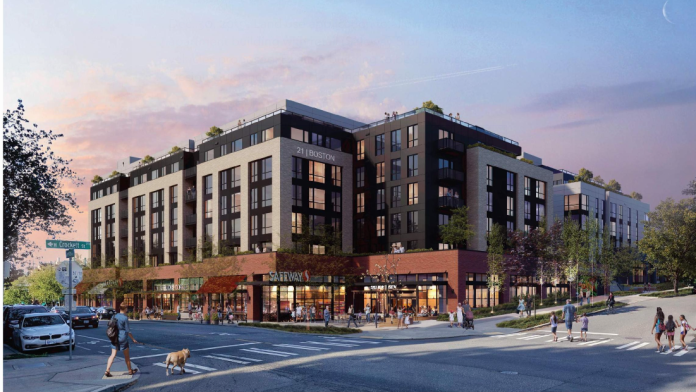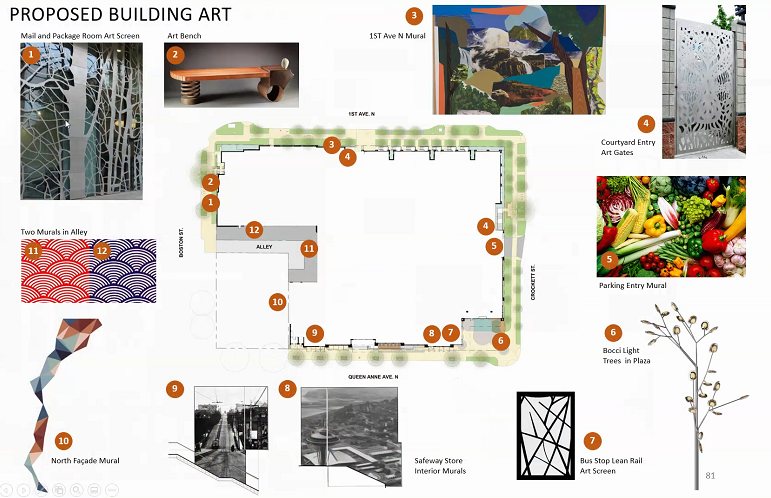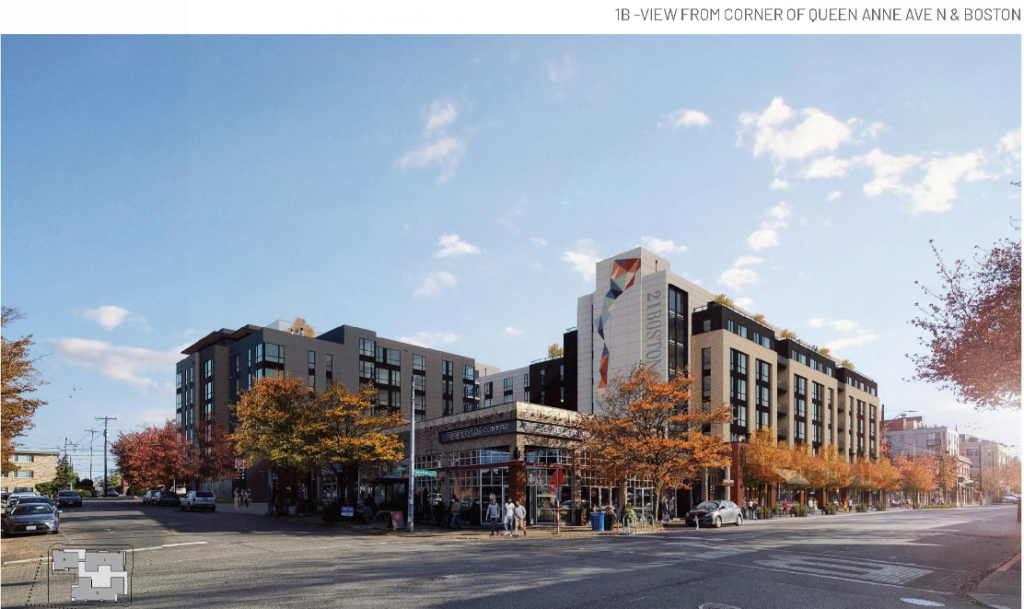
Facing gripes about brick color and other minutia, 323 homes will need to wait.
In 1994, Councilmember Jim Street proudly predicted Queen Anne would be effectively off limits to new development thanks to the interventions of anti-housing activists in the neighborhood planning mandated by the 1990 Growth Management Act.
“I’m prepared to predict, as we speak, that planning in Queen Anne will be as close to zero (in increasing density) as you can possibly get,” Street said, discussing the Queen Anne Urban Village designation, which was skinny enough on top of the hill to keep most of the tawny neighborhood off limits–especially when paired with the need for approval from groups infiltrated by homeowner activists.
Last night, Queen Anne took another step toward proving out Street’s prediction, as the local design review board yet again declined to approve a design for Queen Anne’s Safeway redevelopment in the works since the Obama administration. The project would bring 323 homes atop a brand new expanded Safeway grocery store along with streetscape improvements. At 474,000 gross square feet (minus exemptions for residential underground parking and ground-floor retail) in an “M1 intensity” 75-foot zone, the development would contribute about $10 million $6 million in Mandatory Housing Affordability (MHA) payments or set aside 29 homes on-site for low-income households (below 60% of area median income) due to 9% affordability requirements in the zone.
The West Design Review Board didn’t seem too concerned about housing affordability as it required the developer to come back yet again with revisions at another meeting to address their nit-picking about minor design features. In a marathon three-and-a-half-hour meeting, boardmembers quibbled with all manner of details from the proper size of planters, modulating storefronts, the number and caliber of businesses likely to call that frontage home, and whether the developer has really earned it.
Murals were promised on every blank wall, brick added in abundance, bocci light trees sprouted, festival lights strewn about, benches made arty, gates customized with metal latticework, and a pedestrian plaza promenading through the whole shebang, but still it wasn’t enough to impress the board.

The City planner tasked with the project, Joe Hurley, commended the board’s thoroughness and commented they should erect a statue of the developer and architect if they make it through this gauntlet, which seems a terrible way to run a city if it feels like winning the Super Bowl to get a simple apartment building built. “I’m glad the Board is doing a really good, thorough, deliberative review,” Hurley said, calling the project “legendary” as reported by Mark Ostrow of Queen Anne Greenways, who tweeted the meeting.
To some urbanists and pro-housing activists from the sidelines, the continued delay of this Queen Anne project was calling into question the very existence of the design review process in its current format. The design review boards consist of five volunteer members appointed by the Mayor and City Council. One seat is reserved for a design professional, two for community members, one for a development professional, and one for a business or landscape design professional. Meetings are staffed by one City planner from the Seattle Department of Construction and Inspections–Hurley in this case.
The West Design Review Board is composed of Brian Walters as the design professional, Steven Porter as the development professional, Jen Montressor as the landscape design professional and business representative, and Patreese Martin and John Morefield as community representatives, though both are architects too. All five members are White, it would appear, which is true of most of the eight design review boards. (The Central Design Review Board is the only one with a Black member while no Latinos appear to be represented on any of the boards.)
Since semi-regular four-hour evening meetings are a requirement of participation in these unpaid positions, it’s no surprise design review board members skew White, wealthy, and toward industry professionals–who at least get a résumé and reputational boost out of it. While there’s no direct compensation, learning strategies to make it through design review can be a valuable skill, even if it’s a moving target.

The argument for the review boards is that the feedback and threat of not getting a recommendation improves designs and that a venue for volunteer professionals to vet designs and community members to vent their concerns can help avoid lawsuits. Critics counter that designing by committee actually weakens concepts and can compromise the architectural vision–and some board-delayed projects still get sued anyway. Skeptics argue the time-consuming process adds to project costs, prevents worthy projects from seeing the light of day, and exacerbates our housing affordability crisis.
The Seattle City Council has the authority to reform the design review board or jettison it, and it can raise State Environmental Policy Act (SEPA) thresholds so fewer housing projects are subject to environmental appeals. It’s probably time again given the continued obstruction in the midst of a pandemic wrapped in a housing crisis sitting on the edge of a tidal wave of evictions once the state and city eviction bans are lifted. Design review reforms passed in 2017 don’t seem to have solved the fundamental problems with the program.
Barrientos Ryan is the developer behind the latest iteration of the Queen Anne Safeway project, and principal Maria Barrientos is well-respected and well-connected–a member of the Housing Affordability and Livability Agenda committee that negotiated 65 recommendations and cleared the way for the MHA program that paired upzones in all urban villages and centers with inclusionary zoning requirements boosting affordable housing production. But a developer with a strong track record could not melt the walls the West Design Review Board have put up around Upper Queen Anne in partnership with the Queen Anne Community Council and City leaders of yore.

The Queen Anne Community Council got a preview of the new design a few weeks ago, which was supposed to smooth things over. But the board still came out swinging. Perhaps it shouldn’t be a surprise given Queen Anne’s history–from the neighborhood’s inception Upper Queen Anne has been synonymous with Seattle’s upper crust. With former council leader Marty Kaplan leading the charge, Queen Anne Community Council spearheaded the legal challenge against backyard cottage reform and it joined the coalition that challenged the MHA rezones unsuccessfully, though did delay both more than a year.
Ostrow reports that Kaplan has recently moved into his second home in Idaho and sold his Queen Anne estate–though he still video conferenced into the meeting and talked like he owned the neighborhood. It’s pretty remarkable that modest efforts at expanding social housing and middle-income housing options have been blocked so extensively and repeatedly. It’s even more remarkable that policies aimed at helping struggling folks afford one home have been thwarted by a guy who had not one but two luxurious homes this whole time. The City of Seattle should really think on that as it contemplates what to do next and to whom to heed and empower with its structures.
Correction: This piece has been updated to note the MHA payment will likely be closer to $6 million when factoring in exemptions for resident parking and ground-floor retail. I had calculated that number to be nearly $10 million without those generous exemptions.
Doug Trumm is publisher of The Urbanist. An Urbanist writer since 2015, he dreams of pedestrian streets, bus lanes, and a mass-timber building spree to end our housing crisis. He graduated from the Evans School of Public Policy and Governance at the University of Washington in 2019. He lives in Seattle's Fremont neighborhood and loves to explore the city by foot and by bike.

